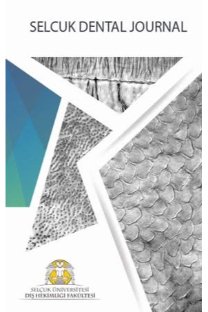The interdisciplinary treatment of anterior openbite
İskeletsel ön açık kapanışlar genellikle maksilla ve mandibulanın posterior dentoalveoler segmentinde aşırı büyüme ile karakterize maloklüzyonlardır. İskeletsel açık kapanış tedavileri için pasif ısırma bloğu, oksipital headgear, sabit mekanikler ve vertikal elastikler gibi metotlar kullanılmaktadır. Bu vaka raporunda ; polidiastema ve ön açık kapanışın disiplinler arası tedavisinin sunulması amaçlanmıştır. Yetişkin bayan hasta iskeletsel ve dental sınıf II ilişkilere, 7.8 mm lik açık kapanışa ve artmış ön yüz yüksekliğe sahipti. Planımız: 1-Maksillayı gömmek, mandibulada rotasyon ve ilerletme yapmak 2-Ön dişlerin pozisyonunu düzeltmek 3-Dudak kapanışı ve yüz profilini iyileştirmek 4-İdeal oklüzyonu sağlamak 5- Dental ve gülme estetiğini iyileştirmekti. Ortodontik tedavi sonrası protetik ve periodontal tedaviler uygulandı. Hasta memnuniyeti ile beraber daha iyi bir estetik, iyileştirilmiş gülme ve fonksiyon elde edildi.
Ön açık kapanışın disiplinler arası tedavisi
Skeletal anterior openbites are complicated malocclusions characterized usually by overgrowth of the maxillary-mandibular posterior dentoalveolar heights. Several methods were introduced to treat skeletal openbites such as passive bite blocks, high pull headgears, fixed mechanics and vertical elastics. In this case report, the purpose was to present the interdisciplinary treatment of the skeletal anterior openbite malocclusion and polydiastema. The adult female patient had skeletal (ANB=6°) and dental Class II relationship and 7, 8 mm anterior openbite with increased lower facial height. Our objectives were to: 1- impact maxilla, advance-rotate mandible 2-correct the positions of the anterior teeth 3-enhance facial profile and lip closure 4-establish ideal occlusion 5-improve smile and dental esthetics. Ideal overjet and overbite values were obtained. The prosthodontic and periodontal treatments were performed after orthodontic treatment. Better esthetics, improved smile and function were also obtained with the patient’s satisfaction.
___
- 1. Buschang PH, Sankey W, English JD. Early treatment of hyperdivergent open-bite malocclusions. Semin Orthod 2002;8:130–40.
- 2. Lopez-Gavito G, Wallen TR, Little RM, Joondeph DR. Anterior open-bite malocclusion: a longitudinal 10-years postretention evaluation of orthodontically treated patients. Am J Orthod 1985;87:175–86.
- 3. Iscan HN, Sarisoy L. Comparison of the effects of passive posterior bite-blocks with different construction bites on the craniofacial and dentoalveolar structures. Am J Orthod Dentofacial Orthop 1997;112:171–8.
- 4. Proffit WR. Diagnosis and treatment planning. In: Contemporary Orthodontics 2nd ed. Mosby Year Book St Louis; P:236–237, 1996.
- 5. Kim YH. Anterior openbite and its treatment with multiloop edgewise. Angle Orthod 1987;57:290–321.
- 6. Kim YH, Han UK, Lim DD, Serraon MLP. Stability of anterior open bite correction with multiloop edgewise archwire therapy: a cephalometric follow-up study. Am J Orthod Denofacial Orthop 2000;118:43–54.
- 7. Rinchuse DJ. Vertical elastics for correction of anterior openbite. J Clin Orthod 1994;28:284.
- 8. Buschang PH, Sankey W, English JD. Ealy treatment of hyperdivergent open-bite malocclusions. Semin Orthod 2002;8:130–140.
- 9. Hiller ME. Nonsurgical correction of Class II open bite malocclusion in an adult patient. Am J Orthod DentofacOrthop 2002;122:210–216.
- 10. Denison TF, Kokich VG, Shapiro PA. Stability of maxillary surgery in open bite versus non-open bite malocclusions. Angle Orthod 1989;59:5–1.
- 11. Epker BN, Fish LC. Superior surgical repositioning of the maxilla, long term results. J Max Fac Surg 1981; 9:237- 246.
- 12. Hiranaka DK, Kelly JP. Stability of simultaneous orthognathic surgery on the maxilla and mandible:a computer assisted cephalometric study. Int J Adult Orthod Orthognath Surg 1974;4:193-213.
- 13. Wiclh TB. Stability in the correction of dentofacial deformities:a comprehensive review. J Oral Maxillofac Surg 1989; 47:1142-1149.
- 14. Lello GE. Skeletal openbite correction by combined Le- Fort I osteotomy and bilateral sagittal split of the ramus. J Cranio-Max Surg 1987;15:132-6.
- 15. Proffit WR, Philips C, Turvey TA. Stability following superior repositioning of the maxilla by LeFort I osteotomy. Am J Orthod Dentofac Orthop. 1987;92:151-61.
- 16. Satrom KD, Sinclair PM, Wolford LM. The stability of double jaw surgery: a comparison of rigid versus wire fixation. Am J Orthod Dentofac Orthop 1991;99:550-63.
- 17. Bailey TJ, Phillips C, Proffit WR, Turvey TA. Stability following superior repositioning of the maxilla by LeFort I osteotomy, five year follow up. Int J Adult Orthod Orthognath Surg 1994;9:163-73.
- 18. Bishara SE, Chu GW, Jakobsen JR. Stability of the LeFort I one piece maxillary osteotomy. Am J Orthod Dentofac Orthop 1988;94:184-200.
- 19. Haymond CS, Stoelinga PJW, Blijdorp PA, Leenen RJ, Merkens NM. Surgical orthodontic treatment of anterior skeletal open bite using small plate internal fixation. Int J Oral Maxillofac Surg 1991;20:223-27.
- 20. Ellis E, McNamara JA Jr. Components of adult Class II open bite malocclusion. J Oral Maxillofac Surg 1985;43:92-105.
- 21. Krekmanov L, Lilja J, Ringqvist M. Simultaneous correction of maxillary and mandibular dentofacial deformities without the use of post-operative intermaxillary fixation. Int J Oral Maxillofac Surg 1988;17:363-70.
- 22. Nordquist GG, McNeil RW. Orthodontic vs restorative treathment of the congenitally absent lateral incisor - Long term periodontal and occlusal evalıatuation. J Periodontol 1975;46:139-43.
- ISSN: 1300-5170
- Yayın Aralığı: Yılda 3 Sayı
- Başlangıç: 1991
- Yayıncı: İsmail Marakoğlu
Sayıdaki Diğer Makaleler
In vitro evaluation of shear bond strengths of different flowable resins
Fatma CEBE, Mehmet Ata CEBE, EMİNE ŞİRİN KARAARSLAN, Necdet ADANIR, Bora ÖZTÜRK
NEVİN ÇOBANOĞLU, Ali Rıza ÇETİN
Farklı ışık kaynaklarının fissür örtücülerin bağlanma dayanımları üzerine etkisi
Murat Selim BOTSALI, Yağmur ŞENER
The interdisciplinary treatment of anterior openbite
SERTAÇ AKSAKALLI, Celal IRGIN, Zekeriya TOSUN, Özgür İNAN
